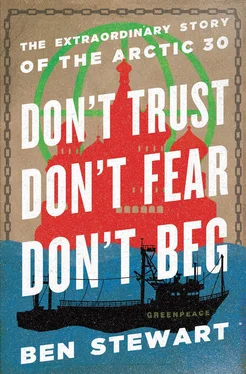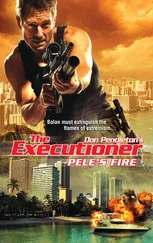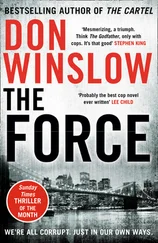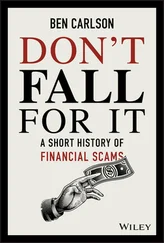A march was organised from Selma to Montgomery, the state capital, to petition the avowedly racist governor George Wallace. The peaceful marchers were met by state troopers who beat them and rained canisters of tear gas onto the heads of the crowd. [90] http://www.nps.gov/nr/travel/civilrights/al4.htm
Two weeks later eight thousand people assembled at Brown Chapel in Selma and, led by Martin Luther King Jr., they set out again for Montgomery. By the time they arrived on the steps of the State Capitol building four days later, [91] http://www.nps.gov/semo/historyculture/index.htm
the crowd had swelled to twenty-five thousand. [92] http://news.bbc.co.uk/onthisday/hi/dates/stories/march/28/newsid_4264000/4264241.stm
Among their number were Roger Willcox and his twelve-year-old son, Pete.
Dr King addressed the crowd:
We must come to see that the end we seek is a society at peace with itself, a society that can live with its conscience. That will be a day not of the white man, not of the black man. That will be the day of man as man. I know you are asking today, ‘How long will it take?’ I come to say to you this afternoon, however difficult the moment, however frustrating the hour, it will not be long, because truth pressed to earth will rise again. How long? Not long, because no lie can live for ever. How long? Not long, because you still reap what you sow. How long? Not long. Because the arc of the moral universe is long but it bends toward justice. [93] http://iipdigital.usembassy.gov/st/english/publication/2009/01/20090107151130srenod0.5167658.html#axzz3EDtsZjvF
Pete later told the journalist Josh Eells that the march instilled in him ‘the notion that if you dedicate yourself to something outside your immediate sphere, it’s going to be a more fulfilling life’. [94] http://www.mensjournal.com/magazine/pete-willcox-high-seas-avenger-20140324
Most American schoolchildren are sent to summer camp. When he was fourteen years old the parents of Pete Willcox sent him to the Soviet Union. It was 1967, the year before Pavel Litvinov sat down in Red Square to protest the invasion of Czechoslovakia. For Roger and Elsie the USSR didn’t hold the same demonic connotations that it did for most Americans. Pete spent several weeks touring the country, visiting a Russian school and eating austere Russian meals. He took a train from Moscow to Crimea, where he spent six weeks at Camp Artek, the famous retreat for the children of party members and international delegations (Yuri Gagarin, the first man in space, was at the camp that summer [95] http://www.sciencephoto.com/media/152694/view
). Again and again Pete met Russians who yearned for peace, for better relations with America.
When he was nineteen years old he was drafted to fight in Vietnam. Soon afterwards he took a call from the wife of the folk singer Pete Seeger, a family friend. The Seegers had an offer to make. They owned a boat and used it to teach local children about pollution in the Hudson river. The first mate had recently been tried for draft evasion but had somehow persuaded the judge that the crew of the boat should be exempted from the military. If Pete wanted, he could join the crew and avoid Vietnam. [96] http://www.mensjournal.com/magazine/pete-willcox-high-seas-avenger-20140324
Pete Willcox eventually became captain of Seeger’s boat. He dated the cook Maggy, it was love but it didn’t last. She married another guy, but they stayed in touch.
After six years of educating kids about one dirty river in one state, Pete was getting itchy feet. In 1981, at the age of twenty-eight, he answered an advert in a magazine for a job as a deckhand for Greenpeace. On day one, because he was a good painter, he was made the new first mate. Three months later he was captain. Six months after that he was sued for piracy for the first time after taking part in a direct action protest against toxic waste dumping off the New Jersey coast. Two years later came a second piracy charge, this time for boarding a Japanese whaling ship. [97] http://www.mensjournal.com/magazine/pete-willcox-high-seas-avenger-20140324
Then in 1985, the French secret service bombed his ship, the Rainbow Warrior , and killed his friend, the photographer Fernando Pereira.
Two of the bombers – Captain Dominique Prieur and Commander Alain Mafart – were arrested by local police. [98] http://www.academia.edu/1005097/The_Rainbow_Warrior_bombers_media_and_the_judiciary_Public_interest_v_privacy
Three other French agents were arrested by the Australian authorities but were released and picked up by a French submarine. [99] http://www.theguardian.com/environment/2005/jul/15/activists.g2
Four months later Prieur and Mafart were sentenced to ten years’ imprisonment for manslaughter, [100] http://www.academia.edu/1005097/The_Rainbow_Warrior_bombers_media_and_the_judiciary_Public_interest_v_privacy
but the French government threatened economic sanctions against New Zealand unless the agents were freed. [101] David Lange, My Life (Auckland, 2005), pp. 222–3, pp. 274–5.
A political deal was struck that saw the bombers held on a French Polynesian island, but after just two years they were released and returned to France, where Mafart was promoted to the rank of lieutenant colonel. [102] Terry Crowdy, Military Misdemeanours: Corruption, Incompetence, Lust and Downright Stupidity (Oxford, 2007), p. 246.
It later transpired that President François Mitterrand knew about the plan to bomb the Rainbow Warrior before it was executed. [103] http://www.thetimes.co.uk/tto/news/world/article1980551.ece
The leader of the team that planted the bombs was reported to be Louis-Pierre Dillais. He later moved to the United States and settled in Virginia, where he still lives, running the American arm of a Belgian weapons manufacturer. [104] http://www.theguardian.com/environment/2007/may/25/usnews.france
Pete was devastated by Fernando’s death. He took a year out, sailed a bit, took time to reflect. Eventually he was ready to get back to campaigning. Soon he was being arrested in Denmark, then the Philippines. A movie came out, The Rainbow Warrior , in which Pete was played by Oscar-winner Jon Voight. Years passed. Greenpeace grew in size and scope. The job of captain changed.
‘When I started out, there was one campaigner on the boat, and half the time his job was to bring the recreational pharmaceuticals,’ Pete told Josh Eells from the magazine Men’s Journal . ‘Now there’s a campaigner, an assistant campaigner, a comms person, a second comms person, a webbie, photographer… I remember saying in the early eighties that we had to get as disciplined and organised as IBM or Exxon, or we weren’t going to matter. And in a lot of ways we did, and it sucks. I’m still glad we did it. But now you’re kind of just a cog in a wheel.’ [105] http://www.mensjournal.com/magazine/pete-willcox-high-seas-avenger-20140324
Pete met an Argentine doctor at sea, married her and had two kids, but the marriage didn’t last. Later he connected with his birth mother, then in 2010 he was visiting Maine to pick up a classic yacht for delivery when he met up with Maggy, the cook back on Pete Seeger’s boat forty years earlier. She was single now, so was he, and that thing between them was still there. Three years later they married. Seven months after that he sailed for the Arctic.
Pete Willcox’s diary
1st November
November! Made it! Good things are going to happen this month, but there are still alligators in the pool. So do not count your chickens yet! Got off to a slightly better exercise period. Two sides of the box were walkable. Then the day got a little weird. I got taken to a room up on the fourth floor which was some kind of meeting room. Two guys, one in a suit, one a plain shirt. They said they were from special services or something like that. The suit started to talk but the other guy was such a shitty translator, it was really hard to figure out what they were trying to say. They made the point that I was responsible for the crew being here. I did not like it, but agreed anyway. They then spent a long time saying if I made a statement things would be better, and we would go home. They asked me what I thought, and I said if that’s what they told me I would have to accept it. They did not whip out the paper and start questioning me. The interpreter was not up to it. But at the end I just agreed with them, saying I did not know anything that was going on, and if they said I would get out after making a statement, I would have to believe them. In the end they might have thought they convinced me. But if they think I am making a statement without my lawyer, they are smoking crack.
Читать дальше












